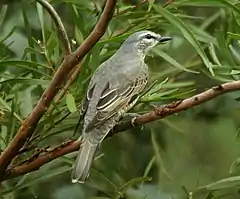| Edolisoma | |||
| Jacquinot & Pucheran, 1853[1] | |||
 Przedstawiciel rodzaju – gąsienicojad cienkodzioby (E. tenuirostre) | |||
| Systematyka | |||
| Domena | |||
|---|---|---|---|
| Królestwo | |||
| Typ | |||
| Podtyp | |||
| Gromada | |||
| Podgromada | |||
| Infragromada | |||
| Rząd | |||
| Podrząd | |||
| Rodzina | |||
| Podrodzina | |||
| Rodzaj |
Edolisoma | ||
| Typ nomenklatoryczny | |||
|
Edolisoma marescoti Jacquinot & Pucheran, 1853 (= Lanius melas Lesson, 1828) | |||
| Synonimy | |||
| |||
| Gatunki | |||
| |||
Edolisoma – rodzaj ptaków z podrodziny liszkojadów (Campephaginae) w obrębie rodziny liszkojadów (Campephagidae).
Zasięg występowania
Rodzaj obejmuje gatunki występujące w Azji Południowo-Wschodniej, Australii i Oceanii[10].
Morfologia
Długość ciała 20–28 cm; masa ciała 41–97 g[11].
Systematyka
Nazewnictwo
- Edolisoma (Edoliisoma, Edoliosoma): rodzaj Edolius Cuvier, 1816 (dziwogon); gr. σωμα sōma, σωματος sōmatos „ciało”[12].
- Eucampophaga (Eucampephaga): gr. ευ eu „dobry”; rodzaj Campophaga Agassiz, 1846 (liszkojad)[13]. Gatunek typowy: Ceblepyris melas S. Müller, 1843 (= Lanius melas Lesson, 1828).
- Metagraucalus: gr. μετα meta „pomiędzy”; rodzaj Graucalus Cuvier, 1816 (kruczyna)[14]. Gatunek typowy: Graucalus tenuirostre Jardine, 1831.
- Graucasoma (Graucasoma): rodzaj Graucalus Cuvier, 1816; gr. σωμα sōma, σωματος sōmatos „ciało”[15]. Gatunek typowy: Edolisoma obiense Salvadori, 1878[uwaga 4].
- Lisomada: częściowy anagram nazwy rodzaju Edolisoma Jacquinot & Pucheran, 1853[16]. Gatunek typowy: Volvocivora insperata[uwaga 4] Finsch, 1875.
- Analisoma: częściowy anagram epitetu gatunkowego Edolisoma anale[17]. Gatunek typowy: Campephaga analis J. Verreaux & Des Murs, 1860.
Podział systematyczny
Takson wyodrębniony z Coracina[18]. Do rodzaju należą następujące gatunki[19]:
- Edolisoma anale (J. Verreaux & Des Murs, 1860) – gąsienicojad rdzaworzytny
- Edolisoma ostentum (Ripley, 1952) – gąsienicojad białoskrzydły
- Edolisoma coerulescens (Blyth, 1842) – gąsienicojad czarniawy
- Edolisoma montanum (A.B. Meyer, 1874) – gąsienicojad czarnobrzuchy
- Edolisoma schisticeps (G.R. Gray, 1846) – gąsienicojad szarogłowy
- Edolisoma dohertyi E. Hartert, 1896 – gąsienicojad jasnoskrzydły
- Edolisoma dispar Salvadori, 1878 – gąsienicojad smolisty
- Edolisoma ceramense (Bonaparte, 1850) – gąsienicojad blady
- Edolisoma insperatum (Finsch, 1876) – gąsienicojad stalowy
- Edolisoma mindanense (Tweeddale, 1879) – gąsienicojad czarnobrody
- Edolisoma melas (Lesson, 1828) – gąsienicojad czarny
- Edolisoma holopolium (Sharpe, 1888) – gąsienicojad lśniący
- Edolisoma admiralitatis Rothschild & E. Hartert, 1914 – gąsienicojad czarnolicy
- Edolisoma salomonis Tristram, 1879 – gąsienicojad okopcony
- Edolisoma remotum Sharpe, 1878 – gąsienicojad melanezyjski
- Edolisoma morio (S. Müller, 1843) – gąsienicojad cykający
- Edolisoma sula E. Hartert, 1917 – gąsienicojad sulański
- Edolisoma incertum (A.B. Meyer, 1874) – gąsienicojad epoletowy
- Edolisoma tenuirostre (Jardine, 1831) – gąsienicojad cienkodzioby
Uwagi
Przypisy
- ↑ H. Jacquinot & J. Pucheran: Voyage au pole sud et dans l’Océanie sur les corvettes l’Astrolabe et la Zélée. Zoologie. Cz. 3. Paris: Gide, 1853, s. 69. (fr.).
- ↑ P.L. Sclater. On the Zoology of New Guinea. „Journal of the proceedings of the Linnean Society”. Zoology. 2, s. 160, 1855. (ang.).
- ↑ F. Heine. Die geographische Verbreitung der Vögel von P. L. Sclater. „Journal für Ornithologie”. 8 (43), s. 43, 1860. (niem.).
- ↑ L.J.F.J. Fitzinger. Über das System und die Charakteristik der natürlichen Familien der Vögel. „Sitzungsberichte der Kaiserlichen Akademie der Wissenschaften. Mathematisch-Naturwissenschaftliche Classe”. 46 (1), s. 199, 1863. (niem.).
- ↑ G.M. Mathews. New generic names, with some notes on others. „Austral Avian Record”. 2 (2 & 3), s. 59, 1913–1915. (ang.).
- ↑ G.M. Mathews. Proposed new names. „Bulletin of the British Ornithologists’ Club”. 45 (295), s. 87, 1925. (ang.).
- 1 2 G.M. Mathews. Bird notes. „Novitates Zoologicae”. 34 (3), s. 372, 1927-1928. (ang.).
- ↑ S.A. Neave: Nomenclator Zoologicus, a List of the Names of Genera and Subgenera in Zoology from the Tenth Edition of Linnaeus, 1758, to the End of 1935. T. 2. London: Zoological Society of London, 1939, s. 516. (ang.).
- ↑ Y.-J. Golvan. Répertoire systématique des noms de genres de Vertébrés. „Annales de parasitologie humaine et comparée”. 36 (5–6), s. 430, 1961. DOI: 10.1051/parasite/1961365826. (fr.).
- ↑ "F. Gill, D. Donsker & P. Rasmussen (redaktorzy)": Bristlehead, butcherbirds, woodswallows, ioras, cuckooshrikes, Shriketit. IOC World Bird List (v13.1). [dostęp 2023-06-05]. (ang.).
- ↑ D.W. Winkler, S.M. Billerman & I.J. Lovette, Cuckooshrikes (Campephagidae), version 1.0, [w:] S.M. Billerman, B.K. Keeney, P.G. Rodewald & T.S. Schulenberg (redaktorzy), Birds of the World, Cornell Lab of Ornithology, Ithaca, NY 2021, Edolisoma, DOI: 10.2173/bow.campep2.01 [dostęp 2023-06-05] (ang.).

- ↑ The Key to Scientific Names ↓, Edolisoma [dostęp 2021-12-27].
- ↑ The Key to Scientific Names ↓, Eucampophaga [dostęp 2023-06-05].
- ↑ The Key to Scientific Names ↓, Metagraucalus [dostęp 2021-12-27].
- ↑ The Key to Scientific Names ↓, Graucasoma [dostęp 2021-12-27].
- ↑ The Key to Scientific Names ↓, Lisomada [dostęp 2021-12-27].
- ↑ The Key to Scientific Names ↓, Analisoma [dostęp 2021-12-27].
- ↑ E. C. Dickinson (Editor), L. Christidis: The Howard and Moore Complete Checklist of the Birds of the World. Cz. 2: Passerines. Eastbourne: Aves Press, 2014, s. 1–752. ISBN 978-0-9568611-2-2. (ang.).
- ↑ Systematyka i nazwy polskie za: P. Mielczarek & M. Kuziemko, Podrodzina: Campephaginae Vigors, 1825 - liszkojady (wersja: 2022-08-15), [w:] Kompletna lista ptaków świata [online], Instytut Nauk o Środowisku Uniwersytetu Jagiellońskiego [dostęp 2023-06-05].
Bibliografia
- The Key to Scientific Names, J.A. Jobling (red.), [w:] Birds of the World, S.M. Billerman et al. (red.), Cornell Lab of Ornithology, Ithaca (ang.).
This article is issued from Wikipedia. The text is licensed under Creative Commons - Attribution - Sharealike. Additional terms may apply for the media files.